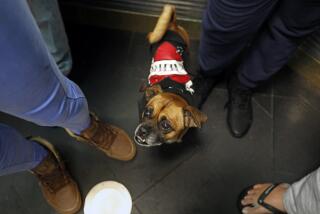Fur Fanciers, Animal Activists Remain at War
- Share via
YELLOWKNIFE, Canada — Doreen Benoit casts a practiced eye on the goose-down parka that has been brought into her shop for “northernizing.”
“Coyote,” pronounces the young Canadian woman. “That’s what you want for the ruff around the hood. Or fox. Wolverine is overrated and really expensive.”
The customer from the United States, where wearing fur is an act of insensitivity in some circles and politically incorrect in others, asks if adding a strip of animal hide to his new parka is really necessary.
Benoit shrugs and notes the temperature outside, a relatively mild 4 below zero. “Depends on whether you want to be warm,” she said.
In Canada’s Northwest Territories, where winters give new meaning to words like “brutal” and “cold,” anti-fur protests from environmentalists and animal-rights activists have had minimal impact on fur sales.
But in the world’s more moderate latitudes such as Europe and the United States, industry sources blame the protests, along with economic hard times and a string of mild winters, for a five-year decline in fur sales.
This year, industry sources contend that the animal-rights movement has run out of steam and fur is coming back.
“We see a lot of factors pointing toward the industry having a pretty good year,” said Carol Wynne of the Fur Information Council of America, headquartered in Herndon, Va. “It won’t be gangbusters, but it should be much better than it has been.”
“There is a demand for the product,” said Stephen Sanders, chief fur-buyer for Marshall Field’s of Chicago, which markets pelts worldwide. “We’re seeing strengths especially in Europe: Spain, Italy and Germany.”
Sanders said some U.S. and European clothing designers are adding fur trim to their fall collections, a development he sees as a harbinger of full fur garments in the next year or two.
Activists in the anti-fur movement discount these industry reports as wishful thinking. They say the fur business is on the ropes.
After a peak of $1.8 billion in 1987, fur sales in the United States dropped almost 45% to $1 billion last year, according to Fur Information Council estimates. In Denmark, the world’s top fur exporter, about 1,000 breeders have gone out of business in recent years.
People have questioned the morality of humans using animals at least since the Greek historian Plutarch raised the issue 2,000 years ago.
Beginning in the mid-1950s, protests against the bludgeoning of baby harp seals in Canada riveted public attention on the animal-rights dispute.
Anti-fur protests in the 1960s focused mainly on trappers and hunters, but later widened to include farm-bred animals such as mink. Tactics have included picketing fur salons and, more recently, social events where furs are worn. Some fur-draped opera patrons have found themselves doused with ketchup.
A recent anti-fur campaign in Italy featured a poster depicting a baby mink staring pitifully at passersby, lamenting, “Somebody else is wearing my mother’s coat.”
The fur industry has always played down the effects of such campaigns. But the protests clearly have taken a toll. Last year, European Community environmental ministers agreed to ban, beginning Jan. 1, 1995, both leg-hold animal traps and imports of skins of animals caught in such traps. Animals affected include wolves, sables, otters, coyotes, lynxes, bobcats, badgers, raccoons, martens, ermines and muskrats.
The industry has responded with its own publicity campaigns, intended to show that the fur trade is neither environmentally unsound nor unacceptably cruel to animals.
The Montreal-based Fur Council of Canada, made up of 22 groups ranging from trappers to retailers, has taken the lead in trying to shore up the industry’s image. The council recently spent some $300,000 on 164 billboards across the country to proclaim the message, “Furs: My Choice, Naturally.”
“We’re trying to get across that there’s nothing wrong with this product, and there’s a lot right with it,” said Alan Herscovici, chairman of the Fur Industry Adjustment Committee, jointly sponsored by the Canadian government and industry.
If industry representatives such as Herscovici are correct, and the market is bouncing back, they can expect to hear even more from people like Dan Mathews of People for the Ethical Treatment of Animals, an animal-rights group headquartered in Washington, D.C.
“We’ll continue public confrontation of those people who still continue to wear fur coats that they’ve bought in the past,” said Mathews. “That’s going to increase a lot this fall, to shame people out of wearing furs.”
More to Read
Sign up for Essential California
The most important California stories and recommendations in your inbox every morning.
You may occasionally receive promotional content from the Los Angeles Times.










